Abstract
Vegetation root water uptake plays a significant role in water transport processes and has multiple effects along the soil–vegetation–atmosphere interface, particularly in semi-arid and arid ecosystems. The objective of this study was to quantitatively examine the water uptake in Cynanchum sibiricum, a common desert rattan plant in arid regions, during its growth period, as well as to assess the relevance of the contributions of various water sources via a multivariate linear mixed model based on water-stable isotopes and eliminating the significant short-term impact of precipitation pulses on root water uptake. The results indicated that when the influence of a precipitation event was minimized, 0–10 cm soil water was the dominant water source for Cynanchum sibiricum in its growth phase, and that the species’ relative uptake of rainfall was positively proportional to that of 10–70 cm soil water while negatively proportional to that of 0–10 cm soil water. We concluded that Cynanchum sibiricum relies on its active roots extending transversely to extract water from shallow soil to survive under extreme drought conditions and would be inseparable from the symbiosis formed with other deep-rooted vegetation. Additional research into disentangling the water transport processes and studying the ecohydrological feedback along the soil–vegetation interface in arid ecosystems would be beneficial and could contribute to the evidence-based management of water resources for ecological protection.
1. Introduction
Vegetation root water uptake has been documented to play a central role in the entangled water transport processes and multiple eco-hydrological responses in the soil–vegetation–atmosphere interface in different ecosystems [1,2]. Transpiration through plants’ leaves is the largest of all terrestrial water fluxes. Particularly in arid regions, root water uptake patterns of various desert species with a high ecological plasticity adapt to the available water resources, resulting in species-specific drought-resistance mechanisms [3,4]. Hence, qualitative and quantitative approaches for measuring root activity and quantifying the magnitude of each contributor, in particular in (semi-)arid regions, have not been extensively studied and remain a challenge in current research efforts [5,6,7,8].
Methods based on water isotopes have been particularly suitable in studying water uptake in plants [8]. Many researchers have studied the vertical water uptake pattern of plants with different functional purposes using water-stable isotopes in arid environments worldwide.
Beyer et al. [5] used natural isotope depth profiles and obtained different source water contributions to the isotopic composition of different tree and shrub species in the Elundu Forest in southern Africa. Antunes et al. [9] derived the seasonal water source used by a proportion of plants with different functional purposes in Mediterranean coastal dune systems with differences in aridity by means of a water isotope. In inland arid regions of northwest China, Jiang et al. [10] quantitatively analyzed the water use strategy of the Nitraria shrub in the growing season at Qingtu Lake in the lower reaches of the Shiyang River by using the isotopic signatures from different sources of water, indicating that Nitraria gradually used deep soil water and groundwater the farther it was located from the lake. Zhou et al. [11] considered the water sources of Populus euphratica and Tamarix ramosissima in the upper riparian zone of the Tarim River and the relationship between the water sources of the plants and their distances from the riverbank using hydrogen- and oxygen-stable isotope technology. Li et al. [12] investigated the root water use pattern and its temporospatial changes in Populus euphratica and Tamarix ramosissima located in the riparian zone of the Ejina Delta in the lower reaches of the Heihe River based on a natural 18O-stable isotope, revealing their responses to groundwater level fluctuations and the hydraulic lift effect.
By reviewing the latest research on this issue, we found that the research objects focused on trees and shrubs. In addition, much of the literature mentioned the significant pulse impacts of unpredictable precipitation events in arid regions on the most usual plant water-use patterns [13].
We employed a multivariate linear mixed model based on water-stable isotopes to identify and quantify the water sources of Cynanchum sibiricum, a prevalent desert symbiotic twining liane, during its growth period while eliminating the significant short-term effects of pulse precipitation events on root water uptake.
The objective of this study was to provide insight into water uptake patterns in Cynanchum sibiricum and other desert rattan species, which can deepen our understanding of water transport processes within the eco-hydrogeological cycle in dry ecosystems as well as provide a scientific basis for the sustainable management and maintenance of desert vegetation.
2. Materials and Methods
2.1. Study Area
Qingtu Lake, the chosen study area, is the tail-end lake of the Shiyang River in northwest China. The lake is in Minqin County, Wuwei city, Gansu Province; its geographical coordinates are 39.04 to 39.09° N and 103.36 to 103.39° E, and its altitude is 1292–1310 m. Located on the northern edge of the Minqin Oasis, Qingtu Lake belongs to the oasis–desert transition zone, with the Badain Jaran Desert and Tengger Desert located in the northwest and southeast, respectively. This area acts as the primary ecological barrier that contains the erosion of the deserts into the oasis areas and blocks the convergence of the two deserts, thus creating a key ecological protection zone that needs to be intensively controlled (Figure 1). Qingtu Lake is situated at a monsoon fringe, with a temperate arid desert climate. The average annual temperature is 7.8 °C, and an effective accumulated temperature of >10 °C can be as high as 3289.1 °C·d. The average annual precipitation is 89.8 mm, and the precipitation from July to September accounts for 73% of the precipitation for an entire year. The potential evaporation capacity is up to 2640 mm, which is approximately 24 times the amount of precipitation. The annual illumination is 318 lh, and northwesterly winds prevail throughout the year.
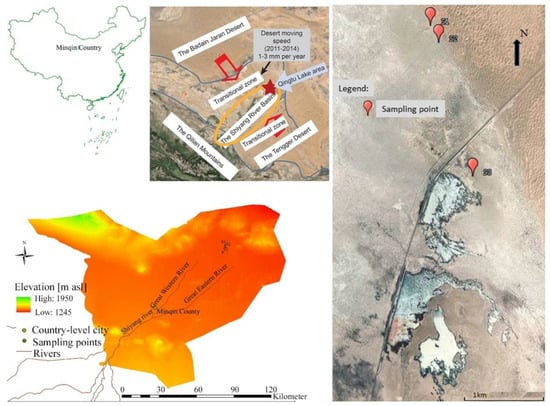
Figure 1.
Digital elevation model and river network of Minqin County and the relative geographical location of Qingtu Lake (i.e., the study area, five-pointed star) as well as sampling locations (sub-circulars).
The research object Cynanchum sibiricum is known as a typical desert symbiotic liane that twines around other vegetation such as Nitraria and Reed and thus likely has a strong interrelationship with them in root water uptake, jointly contributing to windbreaking and sand stabilization.
2.2. Collection and Determination of Samples
There was precipitation on 12 August 2019, and 6 replicates of the rainfall taken at different points were collected on the same day. The samples were placed into 8 mL borosilicate glass bottles, sealed with parafilm, and refrigerated at 2 °C.
A total of 9 plots of 2 × 2 m2 inside 3 (and 3 in each) typical desert plant communities growing Cynanchum sibiricum that were prevalent in the Qingtu Lake area were selected for study. The location and environment of each plot were consistent and representative, including soil condition and microgeomorphology.
Hydrogen- and oxygen-isotope sampling of Cynanchum sibiricum stem water and the soil moisture of various soil layers at three different locations were collected. The specific sampling dates were 20 August 2019, at S1 (8 day later); 22 August 2019, at S3 (10 days later); and 24 August 2019, at S2 (12 days later) (Figure 1).
For the hydrogen- and oxygen-isotope sampling of xylem water in Cynanchum sibiricum, 3 healthy individuals under similar conditions were randomly selected as samples (2 replicates) from each plot. Three corked stems from each individual were collected, cut into 5 cm pieces (length), and the epidermis and phloem were quickly peeled off. Next, the samples were placed in an 8 mL borosilicate glass bottle, sealed with parafilm, and frozen at −10 °C.
For the simultaneous hydrogen- and oxygen-isotope sampling of the soil moisture in different soil layers, on the inner wall of the excavated test pit, appropriate amounts of soil samples (full bottle of dry soil, 2/3-full bottle of wet soil, and ½-full bottle of saturated clay) were collected vertically in 4 layers (0–10 cm, 10–30 cm, 30–50 cm, and 50–70 cm). A total of 3 duplicates was taken for each sample. Then, the samples were placed in an 8 mL borosilicate glass bottles, sealed with parafilm, and frozen at −10 °C.
Water in plant and soil samples was extracted using a cryogenic vacuum distillation system (LI-2100, LICA, Beijing, China). The extraction process required 1.5–3 h depending on the water content of the samples, and the extraction efficiency exceeded 98%. Rain and extracted water were filtered using 0.22 μm organic-phase pin-type filters. Isotopic measurements of all types of water were conducted using a Liquid-Water Isotope Analyzer (912-0050, Los Gatos Research, Los Gatos, CA, USA). The measurement accuracy was ±0.4% for δ2H and ±0.1% for δ18O. According to the international standardized method of the Vienna Standard Mean Ocean Water (VSMOW), all data were calculated to the thousandths.
2.3. Multivariate Linear Mixed Model Method
The multivariate linear mixed model was proposed by Phillips and Gregg [14] and based on the principle of conserving isotopic mass to determine the absorption ratio of plants to each potential water source. Its basic principle is that the hydrogen/oxygen isotope ratio of plant xylem water is equal to the sum of the hydrogen/oxygen isotope ratio of each potential water source multiplied by its share, assuming that no hydrogen/oxygen isotope fractionation occurred while the plant roots were absorbing water from the soil and transporting it to the xylem [15]:
where represents the stable hydrogen/oxygen isotope ratio of plant xylem water; represents the stable hydrogen/oxygen isotope ratio of each potential water source i; and represents the contribution of the potential water source i to the total water used by plants.
Ellsworth and Williams [16] found that D isotopes may undergo fractionation during the transport of water in the stems of xerophytes. In addition, the variation range of D isotopes was significantly wider than that of 18O isotopes, and the sample determination error was larger for D isotopes than for 18O isotopes. Therefore, it was considered more accurate to calculate the contributions of different water sources to plants as opposed to the use of 18O isotopes alone.
When there were more than three potential water sources, the above equations could not be used to determine a single accurate solution. In this case, it was necessary to obtain multiple groups of possible solutions, including a frequency distribution histogram of the share of each potential water source with the help of IsoSource software (version 1.3.1). In the application, the mass-balance tolerance was set as 0.1% and source increment as 1%. The averages calculated through the mathematical statistical analysis of computer sampling data were assumed to characterize the plant water sources and proportions.
3. Results and Discussions
3.1. The Relationships between δ18O and δD in Rainfall, Soil Water, and the Xylem Water of Cynanchum sibiricum
Figure 2 shows the isotopic compositions of the three types of water. There were significant linear relationships between δ18O and δD in rainfall, soil moisture, and xylem water in Cynanchum sibiricum (the smallest R2 among them was larger than 0.74).
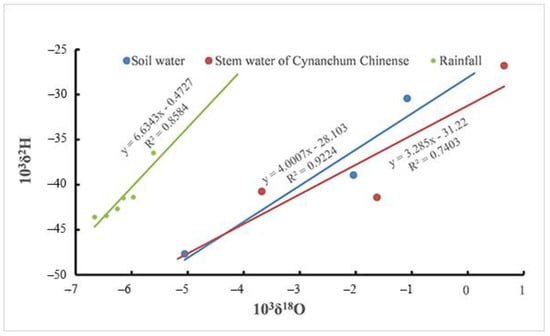
Figure 2.
The relationships between δ18O and δD (regression equations as well as coefficients of determination (R2) included) of rainfall (light green), soil water (blue), and the xylem water (red) in Cynanchum sibiricum. The values for soil water represent the values averaged from surface to a depth of 70 cm.
The variation ranges of rainfall δD and δ18O in the study area corresponded to those in China. The means of rainfall δD (−41.50%) and δ18O (−6.18%) in the study area were smaller than those (−22, −4%) of the globe and larger than those (−50, −8%) in China, indicating that the precipitating air mass underwent a certain degree of depletion and enrichment before reaching the study area [17]. Furthermore, both the slope and intercept of the precipitation line in the study area were lower than those of the globe (δD = 8δ18O + 10) and those in China (δD = 7.48δ18O + 1.01) [18], suggesting that the water vapor in the study area underwent secondary fractionation in the process of precipitation while forming and falling to the ground [19]. Furthermore [11], small, single precipitation events in the inland arid area of northwest China have been easily affected by secondary evaporation under clouds, resulting in strong isotopic dynamic fractionation. Light isotopes were preferentially evaporated, and thus heavy isotopes were concentrated in the falling water, leading to a precipitation line with a decreased slope and intercept.
The soil water and xylem water lines in Cynanchum sibiricum were similar in magnitude and located to the right of the precipitation line with a distinct gap, indicating that rainfall underwent significant evaporation during the infiltration process [11] and that Cynanchum sibiricum significantly withdrew moisture from different soil layers rather than from rainfall.
3.2. Vertical Distribution of δ18O and δD in Soil Moisture
In Figure 3, the soil water isotope profiles from the three sampled locations are shown. The δDs of the three profiles generally declined to a depth of 0.5 m and then were more stable, with the lowest δ values at a 0.5 m depth, which was likely from the isotopic signature of a recent rainfall. This observation was consistent with related results obtained in (semi-)arid regions worldwide [5,9]. The δ18O presented a similar but milder variability.
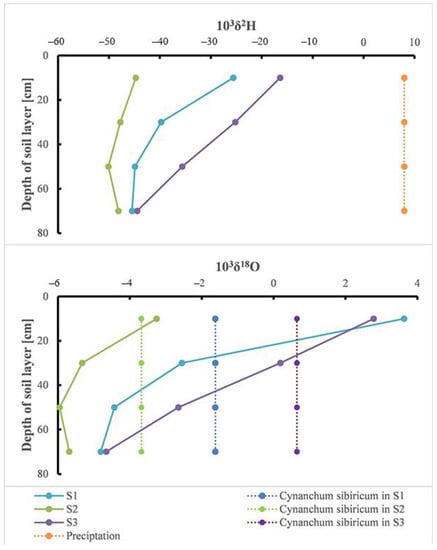
Figure 3.
Soil water 2H values (turquoise line for S1, green for S2, and purple for S3), as well as those of the meteorological water (orange dotted line), and δ18O values (same line type as 2H) as well as those of according xylem water (respective dotted lines) of the species of the three depth profiles.
Evaporation and rainfall infiltration were important factors affecting the vertical distribution of δ18O and δD in soil moisture. Evaporation results in heavy isotope enrichment showed that the shallower the soil layer, the stronger the evaporation effect of soil water and thus the greater the degree of δ18O and δD enrichment. However, the isotopic ratios of soil water decreased with rainfall infiltration. Both of them shaped the vertical distribution of δ18O and δD in soil moisture. Noticeably, at a depth of approximately 0.5 m, the lowest δ values were found; from there, they approached a constant value in deeper layers, indicating that the maximum infiltration depth of rainfall in such arid areas was approximately 50 cm, which was agreement with previous studies [5,19].
In addition, the vertical variation lines of δ18O in S1 and S3 soil moisture intersected with the corresponding δ18O line in Cynanchum sibiricum stem water at ~30 cm and S2 at ~ 70 cm, respectively, indicating that the major water sources of the vegetation in S1 and S3 could be the soil moisture at 30 cm and for S2 at 70 cm, according to other preliminary findings [20].
3.3. The Water Sources and Contributions of Cynanchum sibiricum in the Growth Period
The source water contributions to mean plant isotopic composition, as estimated by IsoSource, are presented in Figure 4. After a relatively long period post-precipitation pulse, and once its influence had faded, all sampled Cynanchum sibiricum growing in S1, S2, and S3 used 0–10 cm soil water, and the maximum contribution of 0–10 cm soil water among them exceeded 83% (Figure 4, Table 1). In addition, the contributions of rainfall and soil water in amounts of 10–30 cm, 30–50 cm, and 50–70 cm to Cynanchum sibiricum growing in S1 were the highest among the three, while that of 0–10 cm was the minimum. In stark contrast, the contributions of rainfall and soil water of 10–30 cm, 30–50 cm, and 50–70 cm in S2 were the minimum while that of 0–10 cm was the highest among the three. The shares of various water sources for Cynanchum sibiricum in S3 were in the middle (Figure 5). In other words, when the relative amount of rainfall absorbed by Cynanchum sibiricum was higher, the proportion of 10–70 cm soil water was larger while the contribution of 0–10 cm soil water was smaller, and vice versa.
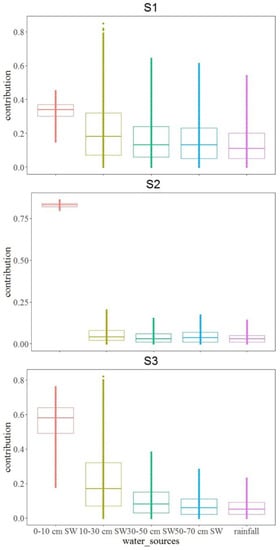
Figure 4.
Boxplots of source water relative uptake (estimated by IsoSource) in the 3 locations and with the 5 sources.

Table 1.
The contributions of various water sources to Cynanchum sibiricum (Mean ±SE (Standard Error)).
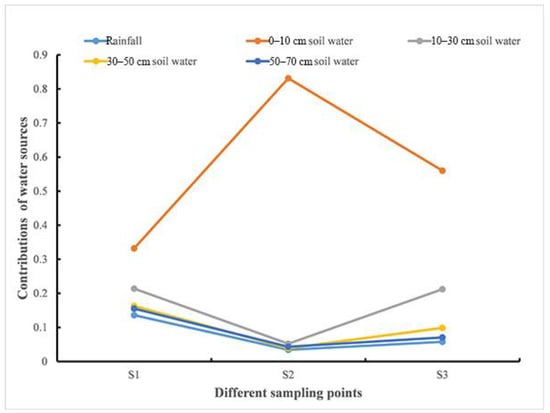
Figure 5.
The relevance of contributions of various water sources to Cynanchum sibiricum during growth period.
Our findings indicated that Cynanchum sibiricum had limited access to the deeper soil water beyond a depth of 10 cm. Therefore, we reviewed our sampling campaign and confirmed that all the vegetation samples were taken from healthy, mature individuals, rather than young individuals whose dimorphic root system, especially the deep penetrating tap roots, may not yet have been fully developed. One possible explanation is that the species under consideration did not necessarily develop dimorphic roots, with only extensive active roots in the near-surface lateral root zone. Cynanchum sibiricum relies on its active roots extending transversely to extract a wide range of soil layers, which is a drought resistance strategy of the species and was consistent with that of T. sericea, a shrub species in semi-arid regions of Africa, as found by Beyer et al. [1].
Meanwhile, as a rattan plant, Cynanchum sibiricum attaches to other species, such as Nitraria and Reed, by twining around them. This has been commonly observed in the field as the species is not able to survive extreme droughts independently. Desert plants have been widely reported to use deep soil water and groundwater with their penetrating tap roots, a practice that is prevalent in arid and semi-arid areas and is crucial to meet their water demands [21,22]. In addition, the hydraulic lift, or hydraulic redistribution, has been observed as a strategy of deep-rooted desert vegetation to mitigate their water stress [23,24]. By symbiosis, Cynanchum sibiricum likely draws water up to the shallow soil layers after it has been transported by the other deep-rooted species.
The positive correlation between the contribution of rainfall and that of 10–70 cm soil water indicated that only when rainfall pulses significantly improved the availability of deeper soil water were the deep roots of the species activated, resulting in an increase in the local absorption of deeper water.
4. Conclusions
Around 50 cm was the maximum infiltration depth of common precipitation in arid areas across northwest China, and its periodic strong function lasted 5–10 days. In contrast to deep-rooted desert vegetation, Cynanchum sibiricum’s drought resistance mechanisms involved the extraction of bulky shallow soil layers using its extensive, near-surface active roots. This study also examined the water uptake strategies of a desert liane during the growth period in arid areas of northwest China while eliminating the significant short-term effects of pulse precipitation events, and the results provided a deeper understanding of the water transport processes in the soil–vegetation cycle for the sustainable management and maintenance of desert ecosystems in arid areas. In future research, the results of our study could be combined with direct evidence obtained on vegetation roots, and the water uptake behavior of Cynanchum sibiricum could be integrated with its symbiotic species so as to reveal the mechanism of their interactions as well as the overall water-use pattern at a plant-community scale. In addition, the artificial isotopic labeling that was applied to the ecohydrological processes could have potential as a research focus.
Author Contributions
Conceptualization, H.D. and J.H.; methodology, Z.C. and J.H.; software, H.D.; validation, J.W.; formal analysis, G.Z.; investigation, J.H., J.W. and H.D.; resources, G.Z. and J.H.; data curation, H.D.; writing—original draft preparation, H.D.; writing—review and editing, Z.C. and G.Z.; visualization, H.D.; supervision, G.Z.; project administration, J.H.; funding acquisition, H.D. and J.H. All authors have read and agreed to the published version of the manuscript.
Funding
This research was funded by China Geological Survey grant numbers SK201909 and SK202107 and G202203-4. The APC was funded by China Geological Survey grant number SK202107.
Institutional Review Board Statement
Not applicable.
Informed Consent Statement
Not applicable.
Data Availability Statement
The data used to support the findings of this study are included within the article.
Acknowledgments
We are thankful to the anonymous reviewers for their valuable comments.
Conflicts of Interest
The authors declare no conflict of interest.
References
- Beyer, M.; Koeniger, P.; Gaj, M.; Hamutoko, J.T.; Wanke, H.; Himmelsbach, T. A Deuterium-based labeling technique for the investigation of rooting depths, water uptake dynamics and unsaturated zone water transport in semiarid environments. J. Hydrol. 2016, 533, 627–643. [Google Scholar] [CrossRef]
- Youri, R.; Mathieu, J. Reviews and syntheses: Isotopic approaches to quantify root water uptake: A review and comparison of methods. Biogeosciences 2017, 14, 2199–2224. [Google Scholar]
- Germon, A.; Laclau, J.P.; Robin, A.; Jourdan, C. Tamm Review: Deep fine roots in forest ecosystems: Why dig deeper? For. Ecol. Manag. 2020, 466, 118135. [Google Scholar] [CrossRef]
- Eamus, D.; Zolfaghar, S.; Villalobos-Vega, R.; Cleverly, J.; Huete, A. Groundwater-dependent ecosystems: Recent insights, new techniques and an ecosystem-scale threshold response. Hydrol. Earth Syst. Sci. Discuss. 2015, 12, 4677–4754. [Google Scholar]
- Beyer, M.; Hamutoko, J.T.; Wanke, H.; Gaj, M.; Koeniger, P. Examination of deep root water uptake using anomalies of soil water stable isotopes, depth-controlled isotopic labeling and mixing models. J. Hydrol. 2018, 566, 122–136. [Google Scholar] [CrossRef]
- Barbeta, A.; Peñuelas, J. Relative contribution of groundwater to plant transpiration estimated with stable isotopes. Sci. Rep. 2017, 7, 10580. [Google Scholar] [CrossRef] [Green Version]
- Berry, Z.C.; Evaristo, J.; Moore, G.; Poca, M.; Steppe, K.; Verrot, L.; Asbjornsen, H.; Borma, L.S.; Bretfeld, M.; Hervé-Fernández, P.; et al. The two water worlds hypothesis: Addressing multiple working hypotheses and proposing a way forward. Ecohydrology 2017, 11, e1843. [Google Scholar] [CrossRef]
- Pierret, A.; Maeght, J.-L.; Clément, C.; Montoroi, J.-P.; Hartmann, C.; Gonkhamdee, S. Understanding deep roots and their functions in ecosystems: An advocacy for more unconventional research. Ann. Bot. 2016, 4, mcw130. [Google Scholar] [CrossRef] [Green Version]
- Antunes, C.; Barradas, M.C.D.; Zunzunegui, M.; Vieira, S.; Pereira, Â.; Anjos, A.; Correia, O.; Pereira, M.J.; Máguas, C. Contrasting plant water-use responses to groundwater depth in coastal dune ecosystems. Funct. Ecol. 2018, 32, 1931–1943. [Google Scholar] [CrossRef]
- Jiang, S.X.; An, F.B.; Ma, J.P.; Zhao, P.; Liu, H.J.; Liu, S.J. Water sources of Nitraria tangutorum nebkhas and its response to ecological water transfer in Qingtu lake in lower reaches of Shiyang river. J. Arid Land Resour. Environ. 2019, 33, 176–182, (In Chinese with English Abctract). [Google Scholar]
- Zhou, T.H.; Zhao, C.Y.; Wu, G.L.; Jiang, S.W.; Yu, Y.X.; Wang, D.D. Application of stable isotopes in analyzing the water sources of Populus euphratica and tamarix ramosissima in the upstream of tarim river. J. Desert Res. 2017, 37, 124, (In Chinese with English Abctract). [Google Scholar]
- Li, Y.F.; Yu, J.J.; Lu, K.; Wang, P.; Zhang, Y.C.; Du, C.Y. Water sources of Populus euphratica and Tamarix ramosissima in Ejina Delta, the lower reaches of the Heihe River, China. Chin. J. Plant Ecol. 2017, 41, 519–528, (In Chinese with English Abctract). [Google Scholar]
- Debandi, G.; Rossi, B.E.; Villagra, P.E.; Giantomasi, M.A.; Mantován, N.G. Spatial and temporal synchronicity in the phenological events of Prosopis flexuosa in the Central Monte Desert. Rev. Fac. Cienc. Agrar. 2020, 52, 148–160. [Google Scholar]
- Phillips, D.L.; Gregg, J.W. Source partitioning using stable isotopes: Coping with too many sources. Oecologia 2003, 136, 261–269. [Google Scholar] [CrossRef]
- Duan, D.Y.; Ouyang, H. Application of stable hydrogen and oxygen isotope in analyzing plant water use sources. Ecol. Environ. 2007, 16, 655–660. [Google Scholar]
- Ellsworth, P.Z.; Williams, D.G. Hydrogen isotope fractionation during water uptake by woody xerophytes. Plant Soil 2007, 291, 93–107. [Google Scholar] [CrossRef]
- Xing, D.; Xiao, J.J.; Han, S.Y.; Peng, G.H.; Fu, W.T.; Jia, Y.L. Water absorption source analysis of mulberry roots based on stable isotopes in rocky desertification area. Trans. Chin. Soc. Agric. Eng. 2019, 35, 77–84, (In Chinese with English Abctract). [Google Scholar]
- Liu, J.R.; Song, X.F.; Yuan, G.F.; Sun, X.M.; Yang, L.H. Stable isotopic compositions of precipitation in China. Tellus B 2014, 66, 39–44. [Google Scholar] [CrossRef] [Green Version]
- Xing, X.; Chen, H.; Zhu, J.; Chen, T. Water sources of five dominant desert species in Nuomuhong area of Qaidam Basin. Acta Ecol. Sin. 2014, 34, 6277–6286, (In Chinese with English Abctract). [Google Scholar] [CrossRef] [Green Version]
- Wang, Y.Y.; Chen, Y.P. Research progress in water uptake models by plant roots. Acta Prataculturae Sin. 2017, 26, 214–225. [Google Scholar]
- Couvreur, V.; Rothfuss, Y.; Meunier, F.; Bariac, T.; Biron, P.; Durand, J.-L.; Richard, P.; Javaux, M. Disentangling temporal and population variability in plant root water uptake from stable isotopic analysis: When rooting depth matters in labeling studies. Hydrol. Earth Syst. Sci. 2020, 24, 3057–3075. [Google Scholar] [CrossRef]
- Arndt, P.; Maren, D.; Rolf, S.; Matthias, C.; Christiane, W. Quantification of dynamic soil–vegetation feedbacks following an isotopically labelled precipitation pulse. Biogeosciences 2017, 14, 2293–2306. [Google Scholar]
- Ceperley, N.; Mande, T.; Rinaldo, A.; Parlange, M.B. Evidence of hydraulic lift for pre-rainy season leaf out and dry-season stem water enrichment in Sclerocarya birrea, a tropical agroforestry tree. EGU Gen. Assem. Conf. Abstr. 2014, 16, 8261. [Google Scholar]
- Yuan, G.F.; Zhang, P.; Xue, S.S.; Zhuang, W. Change characteristics in soil water content in root zone and evidence of root hydraulic lift in Tamarix ramosissima thickets on sand dunes. Chin. J. Plant Ecol. 2012, 36, 1033–1042, (In Chinese with English Abctract). [Google Scholar] [CrossRef]
Publisher’s Note: MDPI stays neutral with regard to jurisdictional claims in published maps and institutional affiliations. |
© 2022 by the authors. Licensee MDPI, Basel, Switzerland. This article is an open access article distributed under the terms and conditions of the Creative Commons Attribution (CC BY) license (https://creativecommons.org/licenses/by/4.0/).